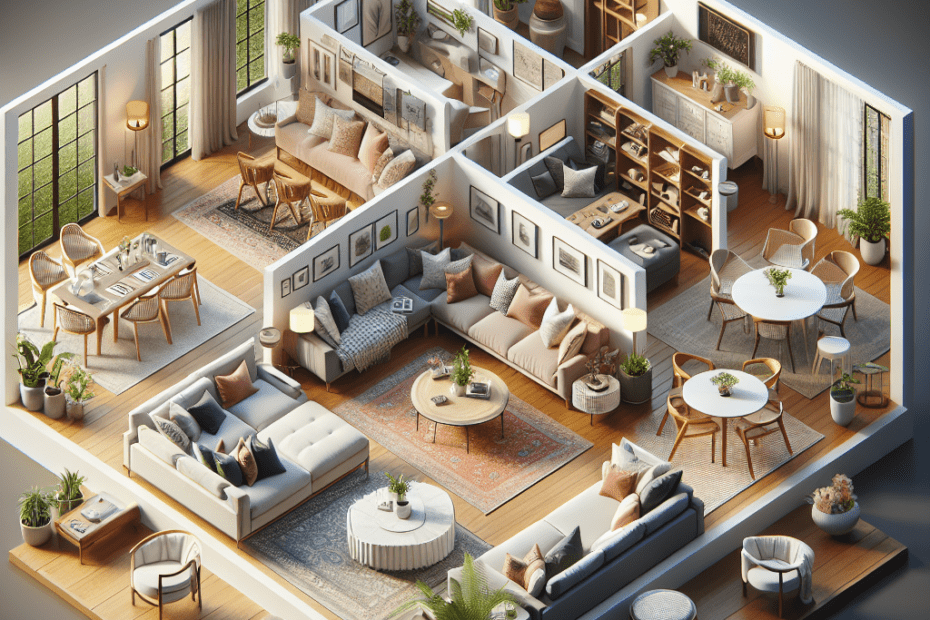Optimizing Open Floor Plan Furniture: Tips for Creating Multiple Zones
Open floor plans are increasingly popular in modern home designs. These layouts offer spaciousness and flexibility that appeal to both families and individuals. However, arranging furniture in open floor plans can be challenging. With the right strategies, homeowners can maximize the functionality and aesthetics of these versatile spaces. According to a report by the National Association of Home Builders, 84% of new homes constructed in 2023 incorporate an open floor plan to some degree, showing the trend’s widespread appeal.
Importance of Defining Zones
Zones help maintain order and functionality in open spaces. They visually divide the space into sections with different purposes, such as relaxation, dining, and study. Proper zoning helps instill a sense of purpose in every area, making the open floor plan feel cohesive yet divided.
Furniture Placement Strategies
- Create Clear Pathways: Ensuring easy movement between zones is essential. Use rugs or furniture as visual cues that guide the flow.
- Use Furniture as Dividers: Sofas, bookshelves, and large tables can serve dual purposes. They provide function while subtly separating spaces.
- Align with Architectural Features: Utilize existing features like columns or fireplaces to enhance and define zones for aesthetic appeal.
Considerations for Each Zone
Each zone in an open floor plan has distinct needs. It’s crucial to select furniture that balances both fashion and function:
| Zone | Furniture Tips |
|---|---|
| Living Area | Opt for sectional sofas that accommodate large groups yet maintain intimacy. |
| Dining Area | Use extendable dining tables that adapt to different occasions. |
| Home Office | Select compact desks and incorporate shelving to maximize storage without sacrificing space. |
Color and Lighting as Zone Tools
Using different colors and lighting schemes can further define and enhance zones. Light fixtures can highlight a specific area, while color schemes can set a mood or indicate a functional shift. According to a study by the American Lighting Association, strategic lighting can improve space utilization by up to 30% by drawing attention and creating ambiance.
Personalizing Open Floor Plans
Ultimately, open floor plans should reflect the personality and lifestyle of those who live in them. Incorporating personal items and decor can add warmth and character while adhering to the broader layout strategy. Consider maintaining harmony by using a consistent color palette and style though diversifying textures and finishes adds depth.
Key Takeaways
- Open floor plans offer flexibility but require thoughtful furniture placement to be functional.
- Defining zones through strategic placement and visual cues creates a cohesive space.
- Furniture can act as dividers and enhance usability while allowing flow across zones.
- Color and lighting are critical tools in distinguishing different functional areas.
- Personalization ensures the open plan resonates with the inhabitants’ lifestyle and taste.
FAQs
A: They provide a spacious feel, facilitate movement and interaction, and are versatile in usage.
Q2: How can I make an open floor plan feel cozy?
A: Layer textiles, use area rugs, and add elements like throw pillows and curtains to create a warm ambiance.
Q3: What role does lighting play in an open floor plan?
A: Lighting distinguishes zones, enhances mood, and can define different areas without physical barriers.
Q4: How can furniture placement improve functionality?
A: Thoughtful furniture arrangement can redirect foot traffic, encourage interaction, and delineate zones.
Q5: Should all furniture match in an open floor plan?
A: While a consistent style is beneficial, varying textures and finishes can prevent monotony and add interest.
In summary, successful open floor plan furniture placement involves careful consideration of zoning, flow, and personal expression. By using strategic design techniques, such as furniture as dividers and tailored lighting, homeowners can create inviting, functional spaces that cater to diverse needs and preferences.
